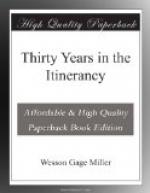At the outset, the Church had been planted in the central portion of the Atlantic States, and had then grown rapidly southward, giving the balance of power to the Conferences where slavery existed. At this juncture, also, by a remarkable change in the commercial affairs of the country, the cotton crop of the South began to find an increasing demand and appreciate in value, thereby giving an increased value to slave labor. With this change came at once the multiplication of slaves and large returns. To own slaves and cultivate cotton now became the ruling inspiration of the people.
At the first the Church stoutly opposed the insetting tide, but as the waves of commercial life grew strong and swept around her, the power of resistance grew more feeble from year to year, until finally some of her own people began to plead extenuation and even tolerance. The conflict was now open, and the result seemed questionable. With the conscience of the Southern portion of the Church asleep or dormant, the anti-slavery side of the issue came finally to depend upon the Church in the North for statement and defence.
At this stage of the conflict the controversy became sectional, the South upholding and the North seeking to remove the evil. Thus the contest raged for years, until the South, growing strong on her ill-gotten gains, and arrogant from her success with the supple-kneed politicians of the North, put the Church in the North upon the defensive by demanding toleration, if not actual adoption. The issue was made in trying to foist upon the whole Church a slave holding Episcopacy. This last act was the feather, if such it might be called, that broke the camel’s back.
The effort was thwarted by the North only through the timely aid of a few of the Central Conferences. At this the South took offence, as is well known, and seceded, carrying with them more than half a million of members and a portion of the Church property. To secure the latter, it is true, long and bitter litigations followed the separation. And it is generally accepted in the North that the decision which gave it to the South took its shape from the political complexion at the time of the Supreme Court of the United States.
It was now thought that the question of slavery was put to rest. But alas! for human foresight. It still remained that the General Rules, which permitted members to hold slaves, provided they did not “buy or sell,” had not been changed. And it was soon found that the awakened conscience of the North could not rest until the last vestige of the nefarious institution was swept from the Church. Agitations, therefore, followed, and each succeeding General Conference found this question to be still the troubler of Israel. Nor was the question left alone to the care of the General Conference. Each annual Conference was also agitated by it.




